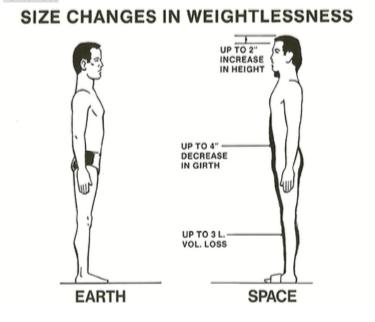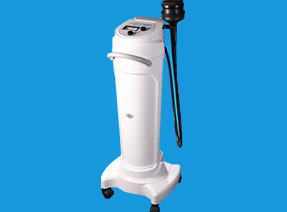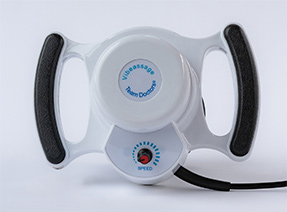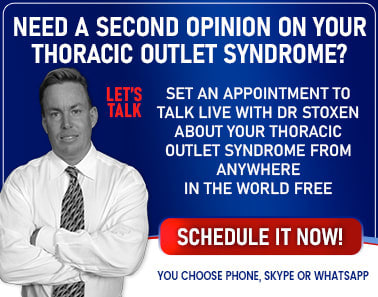What do some of the top teaching hospitals in the world, that specialize in diagnosis and treatment of TOS, say is the cause of thoracic outlet syndrome?
Baylor Heart and Vascular Hospital—The slim space between the collarbone and first rib is called the thoracic outlet. Blood vessels, nerves, and muscles that extend from the back to the arms pass through the thoracic outlet. If this space is too slim, the blood vessels and/or nerves may become abnormally compressed, causing shoulder pain. The compression may also cause impaired circulation or tingling and numbness in the hands. This is known as thoracic outlet syndrome (1).
Johns Hopkins Hospital—The thoracic outlet is a bony ring formed by the topmost ribs, just below the collarbone. Threading through the thoracic outlet, from inside the rib cage, is a bundle of nerves, veins, and arteries that serve the shoulder and arm. Thoracic outlet syndrome occurs when those nerves or blood vessels become compressed, leading to pain, numbness, and circulation issues (2).
Washington University School of Medicine—Neurogenic TOS is characterized by compression of the brachial plexus nerve roots (C5 to T1) within the scalene triangle and/ or subpectoralis space (3).
I think it’s safe to say that most doctors and scientists believe that compression is the cause of thoracic outlet syndrome. Now, let me ask you two extremely important questions.
- What is the only tissue that can compress or move body parts? Answer: Muscles.
- What controls the tension on muscles? Answer: The brain and the nervous system.
The nervous system is the processing and control center of the body.
- The sensory system provides the information to the brain from the bottom, up.
- The brain is the central computer that processes this sensory information, then makes changes on the muscle tension.
The nervous system controls the muscle contraction, which changes tension across the mechanism. This change in tension can be felt as increased tension or increased spring stiffness, decreased tension, or increased spring compliance. This is the normal control of spring tension.
The brain knows the precise amount of tension to apply to the muscles to absorb the force of you stepping down from the curb or from jumping down from a 3-foot box.
The brain knows the exact amount of tension to let off the spring so you can run barefoot on concrete safely or the increased tension on tendons to spring off fast from the ground to run faster.
When the nervous system creates an abnormal, damaging internal compression force, this tension can become an over control of tension of your human spring. I named this pathologic spring tension. This pathologic spring tension is the most common cause of the compression that causes thoracic outlet syndrome.
The next two chapters explain in detail how your nervous system controls this tension. I assure you it is vitally important for you to know, because it will shape all the activities of your daily life that cause and perpetuate the compression that led to thoracic outlet syndrome and other compressive disorders, such as herniated discs, shin splints, degeneration, and accelerated aging of your joints.
What you learn in the next two chapters will also help you to determine which of the 16 different treatment options available to your doctor or healthcare professional is deemed appropriate. It also gives you the information necessary to better understand the self-help treatments recommended in Chapter 13, “What Works and Why.”
In fact, it will shape every decision you make in your activities of daily living, because your brain is going to use what it learns from this reflex to either improve your health or make it worse. So, with that, let’s “spring” into learning, so to speak.
Nervous System Reflexes and Learned Behaviors
Your body is an object that is controlled by your nervous system. The nervous system controls you by way of learned behaviors and reflexes.
Following are five important functions of your nervous system, involving tensions on your body’s spring.
- The nervous system can reduce the stiffness of the muscles and tendons that support the spring to reduce stiffness to make it more compliant and better able to absorb the forces of impacts of walking and running on different surfaces. However, when the spring is more compliant, your body needs more energy to move.
- The nervous system can also adjust the tension on the spring to make it stiffer, so the spring bounces your body off the ground with more efficiency and speed. The stiffness on the spring allows the muscles to stack the bones in a more perpendicular orientation to gravity. With increased stiffness, you have less wobble of the bones on landing and when transitioning the weight across the spring too. However, the greater the tension on the spring, the less apt it is to protect you from impacts.
- The nervous system can alter the tension on the spring to adjust for the forces of gravity to control balance, posture, and equilibrium while lying down, sitting, standing, lifting, and other movements.
- The nervous system tightens the tension on the spring when the sensory system signals that it is in a stressful or injured state. Example: When your neck gets injured in a car accident, you have a stiff neck. The stiffness in the neck is a protective reflex increase of tension on the spring (the neck).
- The nervous system can help you by programming every day activities of daily life into programmed patterns, such as walking, talking, or eating.
Nervous System Reflexes
Gravity is constantly compressing your human spring. The human spring is constantly fighting gravity. Your human spring responds to changes in tensions relative to the directional pull of gravity with ref lexes.

In fact, astronauts in space can grow up to 2 inches or more (5 centimeters) while in orbit. That is because their bodies don’t have gravity compressing their human springs. (Maybe a cure for a herniated disc or thoracic outlet syndrome could be to blast you into space for a few weeks) (4).
Astronauts in space can grow up to 2 inches or more (5 centimeters) while in orbit. That is because their body doesn’t’t have gravity compressing their human spring.
We have seen a measurable difference in height in patients after I performed several hours of treatment to remove the internal compression of their bodies spring system. This happened only when working on thoracic outlet syndrome compression which is only in the upper body. In fact less than 2 months prior to the release of this book I had two patients gain considerable amount of height after the spring release component of the treatment.
One 31-year old woman went from a height of 5’4” to 5’5 1⁄2 gaining a full inch and a half. The other patient, a 38-year old male patient got up from the treatment table and his wife said “Oh my God! You are taller!” We actually checked his height and he gained a full 1.5 inches in height. I wouldn’t have believed it but I measured them myself and asked to see what height they put on their drivers license.
You cannot practice better reflexes. However, you can learn how gravity affects reflexes and work with gravity to improve your posture and tonus.
This way you can avoid unhealthy movements and postures that trigger reflexes that can compress your body’s spring and your thoracic outlet.
For a simple short article on the most important reflex to understand that will help you prevent strain on your thoracic outlet muscles go to this article:
#1 Secret to Preventing Neck Pain – Understanding the Righting Reflex
https://www.thoracicoutletsyndrome.com/1-secret-to-preventing-neck-pain-understanding-the-righting-reflex/

Dr James Stoxen DC., FSSEMM (hon) He is the president of Team Doctors®, Treatment and Training Center Chicago, one of the most recognized treatment centers in the world.
Dr Stoxen is a #1 International Bestselling Author of the book, The Human Spring Approach to Thoracic Outlet Syndrome. He has lectured at more than 20 medical conferences on his Human Spring Approach to Thoracic Outlet Syndrome and asked to publish his research on this approach to treating thoracic outlet syndrome in over 30 peer review medical journals.
He has been asked to submit his other research on the human spring approach to treatment, training and prevention in over 150 peer review medical journals. He serves as the Editor-in-Chief, Journal of Orthopedic Science and Research, Executive Editor or the Journal of Trauma and Acute Care, Chief Editor, Advances in Orthopedics and Sports Medicine Journal and editorial board for over 35 peer review medical journals.
He is a much sought-after speaker. He has given over 1000 live presentations and lectured at over 70 medical conferences to over 50,000 doctors in more than 20 countries. He has been invited to speak at over 300 medical conferences which includes invitations as the keynote speaker at over 50 medical conferences.
After his groundbreaking lecture on the Integrated Spring-Mass Model at the World Congress of Sports and Exercise Medicine he was presented with an Honorary Fellowship Award by a member of the royal family, the Sultan of Pahang, for his distinguished research and contributions to the advancement of Sports and Exercise Medicine on an International level. He was inducted into the National Fitness Hall of Fame in 2008 and the Personal Trainers Hall of Fame in 2012.
Dr Stoxen has a big reputation in the entertainment industry working as a doctor for over 150 tours of elite entertainers, caring for over 1000 top celebrity entertainers and their handlers. Anthony Field or the popular children’s entertainment group, The Wiggles, wrote a book, How I Got My Wiggle Back detailing his struggles with chronic pain and clinical depression he struggled with for years. Dr Stoxen is proud to be able to assist him.
Full Bio) Dr Stoxen can be reached directly at teamdoctors@aol.com























